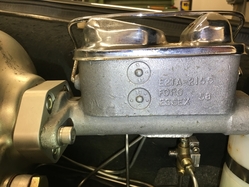I have been rebuilding my brake calipers for quite some time. I finally have things back together. In the process I replaced the master cylinder with a Ford aluminum version that I know many of you have.
Before you ask, yes the brakes have been completely bled. All the seals have been replaced including in the master cylinder. The issue is that the pedal must be pushed a fair amount before the brakes engage. Is this normal for this master cylinder?
Steve




 Then we worked from the furthest away in order. I'm pretty sure it is not air in the system. I larger MC will move more fluid with less travel but will give up some mechanical advantage. I'm wondering where the sweet-spot is for MC bore size? Or, would residual valves in each circuit make it better?
Then we worked from the furthest away in order. I'm pretty sure it is not air in the system. I larger MC will move more fluid with less travel but will give up some mechanical advantage. I'm wondering where the sweet-spot is for MC bore size? Or, would residual valves in each circuit make it better?

